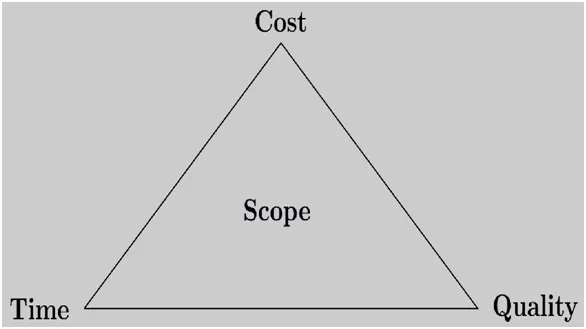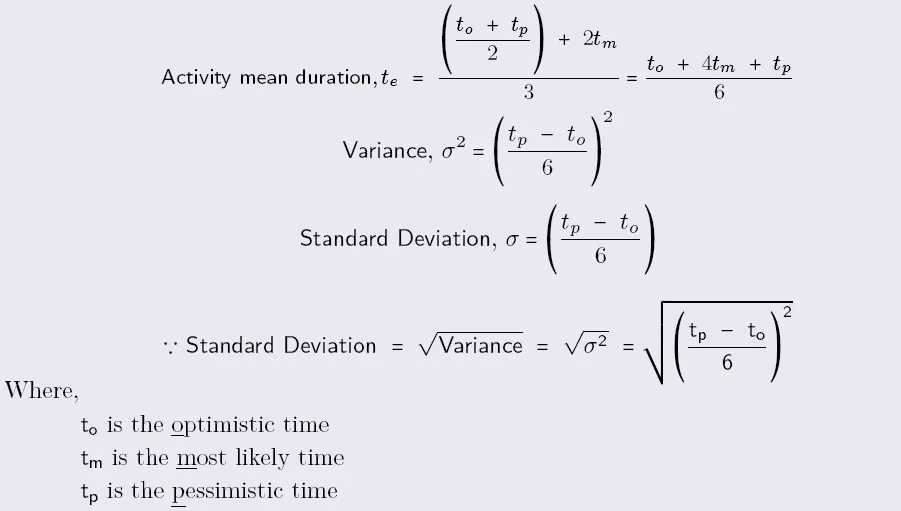
Approximately 54% of Indian construction projects are facing time overruns. From the past records, the time overrun recorded in Indian construction projects ranges from 1 month to 252 months (21 years). The major reasons for these shortcomings are inadequate planning and improper scheduling adapted in these projects.
Planning is the process of choosing an order of work to be adopted for a project from all the various ways and sequences in which it could be done to achieve the overall objectives of the project. Scheduling is the determination of the timing of operations comprising the project and their assembling to give the overall completion time.
The implications of scheduling can be understood using a ‘Project Triangle’. The Project Triangle is also known as the ‘Triple Constraints’, and ‘Iron Triangle’ is a graphic aid where the three attributes showon the corners of the triangle represents the constraints that are required to keep the project in balance. When change is made in any one of the constraints affects at least one of the other two (remaining) constraints as shown in Figure 1.

Construction Scheduling Methods
The following are some of the methods used for scheduling construction projects.
- Gantt Chart – Horizontal Bar Graphs and Timelines
- Project Network Diagramming
- Critical Path Method (CPM)
- Program Evaluation and Review Techniques (PERT)
- Precedence Diagramming Method (PDM)
- Linear Scheduling
- Stochastic Network – Graphical Evaluation and Review Technique (GERT)
- Repetitive Scheduling (RS) and Short-Interval Scheduling (SIS)
Critical Path Method (CPM)
The Critical Path Method (CPM) was first developed by Morgan R. Walker of the Engineering Services Division of DuPont and James E. Kelly Jr. of Remington Rand in 1957. CPM is generally regarded as the activity oriented networks.
- The CPM includes categorization of all activities in the project known as Work Breakdown Structure (WBS) by a technique called Arrow Diagramming
- Determination of duration of the activities, determination of critical activities (activities having maximum duration) and the formulation of Critical Path (path associated with the critical activities) in other words the path associated with the longer duration.
- Ultimately the network is modelled as a linear relationship between cost and time.
- The most important thing to be considered in the CPM is that it is can be applied only to the activities associated with the deterministic durations.
- The CPM can be used to obtain feasible solution for the Least-Cost Scheduling.
- However, CPM accounts only for the determination of earliest completion time but not the probable completion time of project.
Phases of Critical Path Method (CPM)
A basic CPM project network analysis is typically implemented in the following three phases.
- Network-planning phase
- Network-scheduling phase
- Network-control phase
Program Evaluation and Review Techniques (PERT)
- The Program Evaluation and Review Technique (PERT) was developed later in 1958 by the Special Project Office of the U.S. Navy Bureau of Ordnance in association with the management consulting firm of Booz-Allen and Hamilton for managing the Polaris Missile program.
- PERT is generally a statistical network technique that has three important components such as time, resources and technical performance specifications.
- The time assumed for the analysis is probabilistic time (Optimistic Time, Mostlikely time, Pessimistic Time) than the deterministic time as in the case of CPM. Thus the PERT is known as “three time estimate” and it is advantageous over CPM since it not incorporates the duration of any network with some degree of uncertainty but also provides the information regarding the probable completion time of the project.
- Although CPM and PERT were developed independently and from different origins, the methods adopted for computation are quite similar.
- In current practice, the words PERT and CPM are sometimes used interchangeably. PERT was originally developed for control and reporting of complex research and development projects but both the methods computes the critical path in the similar fashion.
- PERT calculates the expected value of activity duration as a weighted average of the three estimates.

Probability of Completing P(T) of a project by a specified duration Ts, or less is given by

To find the project duration that corresponds to a specified % chance of completion, rearranging the variables in equation, we have,

Where,
Te is the project mean duration
σp is the project standard deviation
Other construction scheduling methods like Precedence Diagramming Method (PDM), Linear Scheduling, Stochastic Network – Graphical Evaluation and Review Technique (GERT), Repetitive Scheduling (RS) and Short-Interval Scheduling (SIS) were initially developed independently for industrial sectors and later applied in the construction industry. However, a thorough introspective assessment of these scheduling methods for construction projects is necessary.
Conclusion
The aforementioned construction scheduling methods are not an exhaustive list but the most commonly used scheduling methods. Some of the modern construction project management concepts such as Location Based Management Systems (LBMS), Design Structure Matrix (DSM), and Lean Construction and so on, can be used with these scheduling methods to gain many insights about the project and also to enhance the versatility of the construction scheduling methods.
About Author:
The author is an expert in Applied Artificial Intelligence for Civil Engineering, Automation in Construction, and Building Information Modeling. He also specializes in Constructability Analysis, Construction Project Management, Concrete Formwork Systems, and the integration of Internet of Things (IoT) in Civil Engineering Applications. His work extends to cutting-edge technologies such as Mixed Reality, emphasizing Resilient Design and Construction, as well as Structural Optimization. With a diverse background in these fields, he is dedicated to advancing innovation and efficiency in the civil engineering field.

